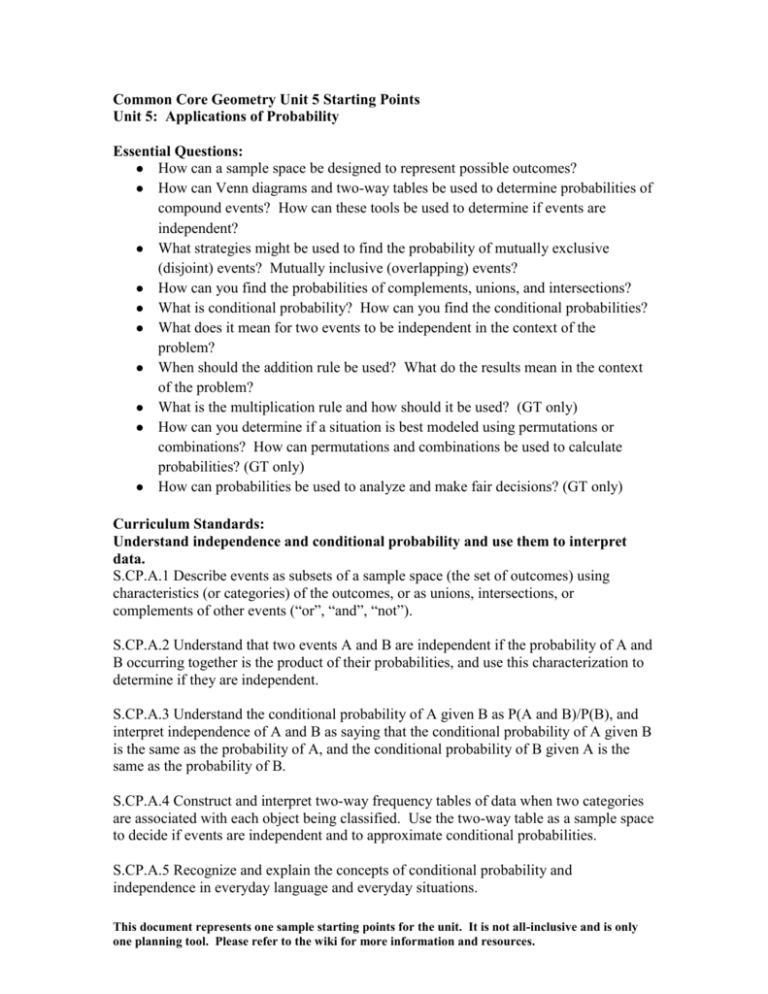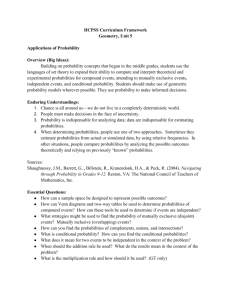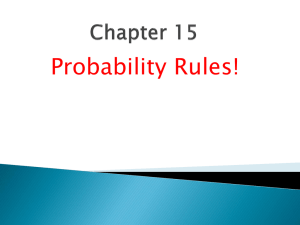02 Common Core Geometry Unit 5 Starting Points
advertisement

Common Core Geometry Unit 5 Starting Points Unit 5: Applications of Probability Essential Questions: ● How can a sample space be designed to represent possible outcomes? ● How can Venn diagrams and two-way tables be used to determine probabilities of compound events? How can these tools be used to determine if events are independent? ● What strategies might be used to find the probability of mutually exclusive (disjoint) events? Mutually inclusive (overlapping) events? ● How can you find the probabilities of complements, unions, and intersections? ● What is conditional probability? How can you find the conditional probabilities? ● What does it mean for two events to be independent in the context of the problem? ● When should the addition rule be used? What do the results mean in the context of the problem? ● What is the multiplication rule and how should it be used? (GT only) ● How can you determine if a situation is best modeled using permutations or combinations? How can permutations and combinations be used to calculate probabilities? (GT only) ● How can probabilities be used to analyze and make fair decisions? (GT only) Curriculum Standards: Understand independence and conditional probability and use them to interpret data. S.CP.A.1 Describe events as subsets of a sample space (the set of outcomes) using characteristics (or categories) of the outcomes, or as unions, intersections, or complements of other events (“or”, “and”, “not”). S.CP.A.2 Understand that two events A and B are independent if the probability of A and B occurring together is the product of their probabilities, and use this characterization to determine if they are independent. S.CP.A.3 Understand the conditional probability of A given B as P(A and B)/P(B), and interpret independence of A and B as saying that the conditional probability of A given B is the same as the probability of A, and the conditional probability of B given A is the same as the probability of B. S.CP.A.4 Construct and interpret two-way frequency tables of data when two categories are associated with each object being classified. Use the two-way table as a sample space to decide if events are independent and to approximate conditional probabilities. S.CP.A.5 Recognize and explain the concepts of conditional probability and independence in everyday language and everyday situations. This document represents one sample starting points for the unit. It is not all-inclusive and is only one planning tool. Please refer to the wiki for more information and resources. Use the rules of probability to compute probabilities of compound events in a uniform probability model. S.CP.B.6 Find the conditional probability of A given B as the fraction of B’s outcomes that also belong to A, and interpret the answer in terms of the model. S.CP.B.7 Apply the Addition Rule, P(A or B) = P(A) + P(B) – P(A and B), and interpret the answer in terms of the model. S.CP.B.8 (+) Apply the general Multiplication Rule in a uniform probability model, P(A and B) = P(A)P(B|A) = P(B)P(A|B), and interpret the answer in terms of the model. S.CP.B.9 (+) Use permutations and combinations to compute probabilities of compound events and solve problems. Use probability to evaluate outcomes of decisions. S.MD.B.6 (+) Use probabilities to make fair decisions (e.g., drawing by lots, using a random number generator). S.MD.B.7 (+) Analyze decisions and strategies using probability concepts (e.g., product testing, medical testing, pulled a hockey goalie at the end of a game). Part I: Probability of Compound Events Approximate Length: 7-10 days (6-8 G/T) Standard(s) Days Notes S.CP.A.1 Big Ideas: 3-4 S.CP.B.7 Generate a sample space for a given compound event (using lists, tree diagrams, etc.). Use Venn diagrams and two-way tables to examine probabilities of compound events. Review notation for probabilities, unions, intersections and complements. Introduce concepts of mutually exclusive (disjoint) and mutually inclusive (overlapping) events. Represent examples with Venn diagrams. Use Venn diagrams to derive the addition rule for compound events. Find probabilities of intersections, unions, and complements. This document represents one sample starting points for the unit. It is not all-inclusive and is only one planning tool. Please refer to the wiki for more information and resources. Resources: Lesson: Unions, Intersections and Complements Lesson: Addition Rule of Probability Assessment Items: Illustrative Mathematics: But Mango is My Favorite S.CP.A.2 S.CP.A.4 4-6 Big Ideas: Define independence of compound events. Examine examples to determine if the events are independent. Construct and use two-way tables to find probabilities of compound events (probabilities out of the total number of outcomes.) Resources: Task: Sample Space Lesson Seed: Independent and Dependent Events Task: All the Pets Assessment Items: Illustrative Mathematics: Cards and Independence Illustrative Mathematics: Rain and Lightning Part II: Conditional Probability Approximate Length: 15-18 days (27-29 G/T) Standard(s) Days Notes S.CP.A.3 Big Ideas: 6-8 S.CP.A.5 Introduce conditional probability. Use two-way tables to find conditional probabilities. Use conditional probability to determine if two events are independent. This document represents one sample starting points for the unit. It is not all-inclusive and is only one planning tool. Please refer to the wiki for more information and resources. Explain what conditional probability and independence means in the context of the problem. Resources: Lesson: Conditional Probability Lesson Seed: Conditional Probability and Independence Assessment Items: Illustrative Mathematics: The Titanic 2 Illustrative Mathematics: Lucky Envelopes Illustrative Mathematics: Breakfast Before School S.CP.B.6 S.CP.A.4 6-8 Big Ideas: Calculate conditional probabilities. Examine examples to determine if the events are independent. Construct and use two-way tables to find conditional probabilities. Resources: Task: Common Characteristics Task: Favorite Baseball Teams Assessment Items: Illustrative Mathematics: The Titanic 1 Illustrative Mathematics: The Titanic 3 Illustrative Mathematics: How Do You Get to School S.CP.B.8 (+) (GT only) 2-3 Big Ideas: Derive and use the multiplication rule. Interpret probabilities in terms of the situation. Resources: Task: Fun Spinner This document represents one sample starting points for the unit. It is not all-inclusive and is only one planning tool. Please refer to the wiki for more information and resources. S.CP.B.9 (+) (GT only) 3-5 Big Ideas: Introduce scenarios to emphasize the difference in sample space for permutations and combinations. Derive formulas for permutations and combinations. Use permutations and combinations to calculate probabilities. Resources: Lesson: Permutations and Combinations Assessment Items: Illustrative Mathematics: Return to Fred’s Fun Factory Illustrative Mathematics: Random Walk III Illustrative Mathematics: Random Walk IV Illustrative Mathematics: Alex, Mel, and Chelsea Play a Game S.MD.B.6 (+) (GT only) S.MD.B.7 (+) (GT only) 3-5 Big Ideas: Describe how to design for a simulation to produce fair results. Calculate probabilities to determine if the scenario is fair. Evaluate probability results to make decisions. Resources: Task: Seating Chart Task: Baseball Outfielders Task: Golden Ticket Assessment Items: Illustrative Mathematics: Fred’s Fun Factory This document represents one sample starting points for the unit. It is not all-inclusive and is only one planning tool. Please refer to the wiki for more information and resources. Howard County Public Schools Office of Secondary Mathematics Curricular Projects has licensed this product under a Creative Commons Attribution-NonCommercial-NoDerivs 3.0 Unported License. This document represents one sample starting points for the unit. It is not all-inclusive and is only one planning tool. Please refer to the wiki for more information and resources.







